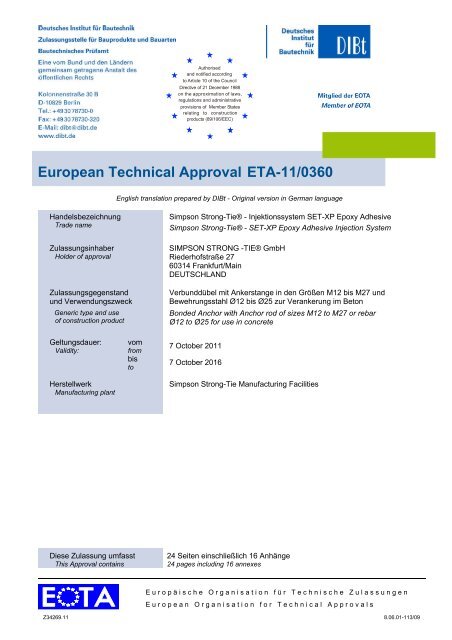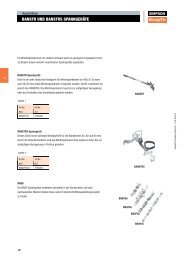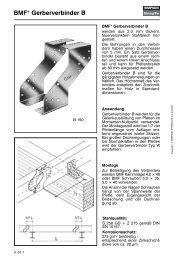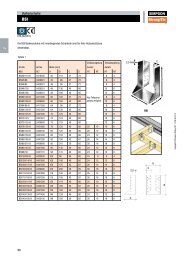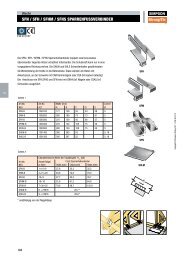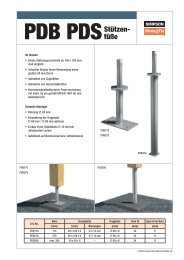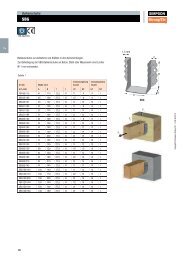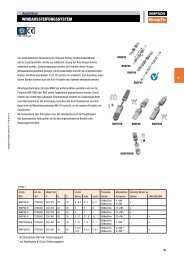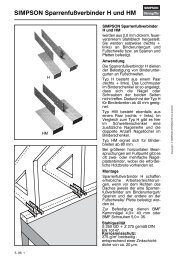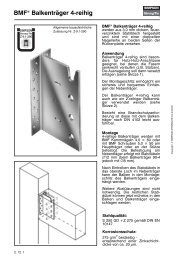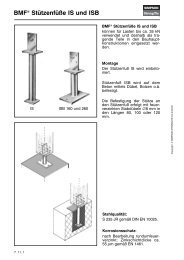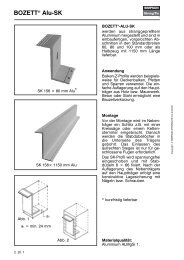European Technical Approval ETA-11/0360 - Simpson Strong-Tie
European Technical Approval ETA-11/0360 - Simpson Strong-Tie
European Technical Approval ETA-11/0360 - Simpson Strong-Tie
You also want an ePaper? Increase the reach of your titles
YUMPU automatically turns print PDFs into web optimized ePapers that Google loves.
<strong>European</strong> <strong>Technical</strong> <strong>Approval</strong> <strong>ETA</strong>-<strong>11</strong>/<strong>0360</strong><br />
English translation prepared by DIBt - Original version in German language<br />
Handelsbezeichnung<br />
Trade name<br />
Zulassungsinhaber<br />
Holder of approval<br />
Zulassungsgegenstand<br />
und Verwendungszweck<br />
Generic type and use<br />
of construction product<br />
<strong>Simpson</strong> <strong>Strong</strong>-<strong>Tie</strong>® - Injektionssystem SET-XP Epoxy Adhesive<br />
<strong>Simpson</strong> <strong>Strong</strong>-<strong>Tie</strong>® - SET-XP Epoxy Adhesive Injection System<br />
SIMPSON STRONG -TIE® GmbH<br />
Riederhofstraße 27<br />
60314 Frankfurt/Main<br />
DEUTSCHLAND<br />
Verbunddübel mit Ankerstange in den Größen M12 bis M27 und<br />
Bewehrungsstahl Ø12 bis Ø25 zur Verankerung im Beton<br />
Bonded Anchor with Anchor rod of sizes M12 to M27 or rebar<br />
Ø12 to Ø25 for use in concrete<br />
Geltungsdauer:<br />
Validity:<br />
Herstellwerk<br />
Manufacturing plant<br />
vom<br />
from<br />
bis<br />
to<br />
7 October 20<strong>11</strong><br />
7 October 2016<br />
<strong>Simpson</strong> <strong>Strong</strong>-<strong>Tie</strong> Manufacturing Facilities<br />
Diese Zulassung umfasst<br />
This <strong>Approval</strong> contains<br />
24 Seiten einschließlich 16 Anhänge<br />
24 pages including 16 annexes<br />
Europäische Organisation für Technische Zulassungen<br />
<strong>European</strong> Organisation for <strong>Technical</strong> <strong>Approval</strong>s<br />
Z34269.<strong>11</strong> 8.06.01-<strong>11</strong>3/09
<strong>European</strong> technical approval<br />
<strong>ETA</strong>-<strong>11</strong>/<strong>0360</strong><br />
English translation prepared by DIBt<br />
Page 2 of 24 | 7 October 20<strong>11</strong><br />
I<br />
LEGAL BASES AND GENERAL CONDITIONS<br />
1 This <strong>European</strong> technical approval is issued by Deutsches Institut für Bautechnik in accordance<br />
with:<br />
- Council Directive 89/106/EEC of 21 December 1988 on the approximation of laws,<br />
regulations and administrative provisions of Member States relating to construction<br />
products 1 , modified by Council Directive 93/68/EEC 2 and Regulation (EC) N° 1882/2003 of<br />
the <strong>European</strong> Parliament and of the Council 3 ;<br />
- Gesetz über das In-Verkehr-Bringen von und den freien Warenverkehr mit Bauprodukten zur<br />
Umsetzung der Richtlinie 89/106/EWG des Rates vom 21. Dezember 1988 zur Angleichung<br />
der Rechts- und Verwaltungsvorschriften der Mitgliedstaaten über Bauprodukte und anderer<br />
Rechtsakte der Europäischen Gemeinschaften (Bauproduktengesetz - BauPG) vom<br />
28. April 1998 4 , as amended by law of 31 October 2006 5 ;<br />
- Common Procedural Rules for Requesting, Preparing and the Granting of <strong>European</strong><br />
technical approvals set out in the Annex to Commission Decision 94/23/EC 6 ;<br />
- Guideline for <strong>European</strong> technical approval of "Metal anchors for use in concrete - Part 5:<br />
Bonded anchors", <strong>ETA</strong>G 001-05.<br />
2 Deutsches Institut für Bautechnik is authorized to check whether the provisions of this <strong>European</strong><br />
technical approval are met. Checking may take place in the manufacturing plant. Nevertheless,<br />
the responsibility for the conformity of the products to the <strong>European</strong> technical approval and for<br />
their fitness for the intended use remains with the holder of the <strong>European</strong> technical approval.<br />
3 This <strong>European</strong> technical approval is not to be transferred to manufacturers or agents of<br />
manufacturers other than those indicated on page 1, or manufacturing plants other than those<br />
indicated on page 1 of this <strong>European</strong> technical approval.<br />
4 This <strong>European</strong> technical approval may be withdrawn by Deutsches Institut für Bautechnik, in<br />
particular pursuant to information by the Commission according to Article 5(1) of Council<br />
Directive 89/106/EEC.<br />
5 Reproduction of this <strong>European</strong> technical approval including transmission by electronic means<br />
shall be in full. However, partial reproduction can be made with the written consent of<br />
Deutsches Institut für Bautechnik. In this case partial reproduction has to be designated as<br />
such. Texts and drawings of advertising brochures shall not contradict or misuse the <strong>European</strong><br />
technical approval.<br />
6 The <strong>European</strong> technical approval is issued by the approval body in its official language. This<br />
version corresponds fully to the version circulated within EOTA. Translations into other<br />
languages have to be designated as such.<br />
1<br />
2<br />
3<br />
4<br />
5<br />
6<br />
Official Journal of the <strong>European</strong> Communities L 40, <strong>11</strong> February 1989, p. 12<br />
Official Journal of the <strong>European</strong> Communities L 220, 30 August 1993, p. 1<br />
Official Journal of the <strong>European</strong> Union L 284, 31 October 2003, p. 25<br />
Bundesgesetzblatt Teil I 1998, p. 812<br />
Bundesgesetzblatt Teil I 2006, p. 2407, 2416<br />
Official Journal of the <strong>European</strong> Communities L 17, 20 January 1994, p. 34<br />
Z34269.<strong>11</strong> 8.06.01-<strong>11</strong>3/09
<strong>European</strong> technical approval<br />
<strong>ETA</strong>-<strong>11</strong>/<strong>0360</strong><br />
English translation prepared by DIBt<br />
Page 3 of 24 | 7 October 20<strong>11</strong><br />
II<br />
SPECIFIC CONDITIONS OF THE EUROPEAN TECHNICAL APPROVAL<br />
1 Definition of product/ products and intended use<br />
1.1 Definition of the construction product<br />
The <strong>Simpson</strong> <strong>Strong</strong>-<strong>Tie</strong>® - SET-XP Epoxy Adhesive is a bonded anchor consisting of a<br />
cartridge with injection mortar SET-XP and a steel element. The steel elements are either<br />
- Threaded rods in the range of M 12 to M 27 or<br />
- Reinforcing bar in the range of Ø 12 to Ø 25<br />
The steel element is placed into a drilled hole filled with injection mortar and is anchored via the<br />
bond between metal part, injection mortar and concrete.<br />
An illustration of the product and intended use is given in Annexes 1 and 2.<br />
1.2 Intended use<br />
The anchor is intended to be used for anchorages for which requirements for mechanical<br />
resistance and stability and safety in use in the sense of the Essential Requirements 1 and 4 of<br />
Council Directive 89/106 EEC shall be fulfilled and failure of anchorages made with these<br />
products would cause risk to human life and/or lead to considerable economic consequences.<br />
Safety in case of fire (Essential Requirement 2) is not covered in this <strong>European</strong> technical<br />
approval. The anchor is to be used only for anchorages subject to static or quasi-static loading<br />
in reinforced or unreinforced normal weight concrete of strength classes C20/25 at minimum<br />
and C50/60 at most according to EN 206:2000-12.<br />
The anchor may be used in cracked or non-cracked concrete.<br />
The anchor may be installed in dry or wet concrete, it must not be installed in flooded holes.<br />
The anchor may be used in the following temperature ranges:<br />
Temperature range I: -40 °C to +43 °C (max long term temperature +24 °C and<br />
max short term temperature +43 °C)<br />
Temperature range II: -40 °C to +65 °C (max long term temperature +43 °C and<br />
max short term temperature +65 °C)<br />
Elements made of zinc coated steel:<br />
The element made of zinc plated or hot dipped galvanised steel may only be used in structures<br />
subject to dry internal conditions.<br />
Elements made of stainless steel:<br />
The element made of stainless steel may be used in structures subject to dry internal conditions<br />
and also in structures subject to external atmospheric exposure (including industrial and marine<br />
environment), or exposure to permanently damp internal conditions, if no particular aggressive<br />
conditions exist. Such particular aggressive conditions are e.g. permanent, alternating<br />
immersion in seawater or the splash zone of seawater, chloride atmosphere of indoor swimming<br />
pools or atmosphere with extreme chemical pollution (e.g. in desulphurization plants or road<br />
tunnels where de-icing materials are used).<br />
Z34269.<strong>11</strong> 8.06.01-<strong>11</strong>3/09
<strong>European</strong> technical approval<br />
<strong>ETA</strong>-<strong>11</strong>/<strong>0360</strong><br />
English translation prepared by DIBt<br />
Page 4 of 24 | 7 October 20<strong>11</strong><br />
Elements made of high corrosion resistant steel:<br />
The element made of high corrosion resistant steel 1.4529 or 1.4565 may be used in structures<br />
subject to dry internal conditions and also in structures subject to external atmospheric<br />
exposure, in permanently damp internal conditions or in other particular aggressive conditions.<br />
Such particular aggressive conditions are e. g. permanent, alternating immersion in seawater or<br />
the splash zone of seawater, chloride atmosphere of indoor swimming pools or atmosphere with<br />
chemical pollution (e. g. in desulphurization plants or road tunnels where de-icing materials are<br />
used).<br />
Elements made of reinforcing bars:<br />
Post-installed reinforcing bars may only be used as anchor designed in accordance with the<br />
EOTA <strong>Technical</strong> Report TR 029. Such applications are e.g. concrete overlay or shear dowel<br />
connections or the connections of a wall predominantly loaded by shear and compression<br />
forces with the foundation, where the reinforcing bars act as dowels to take up shear forces.<br />
Connections with post-installed reinforcing bars in concrete structures designed in accordance<br />
with EN1992-1-1: 2004 are not covered by this <strong>European</strong> technical approval.<br />
The provisions made in this <strong>European</strong> technical approval are based on an assumed working life<br />
of the anchor of 50 years. The indications given on the working life cannot be interpreted as a<br />
guarantee given by the producer, but are to be regarded only as a means for choosing the right<br />
products in relation to the expected economically reasonable working life of the works.<br />
2 Characteristics of the product and methods of verification<br />
2.1 Characteristics of the product<br />
The anchor corresponds to the drawings and provisions given in Annexes 1 to 5. The<br />
characteristic material values, dimensions and tolerances of the anchor not indicated in Annex 1<br />
to 5 shall correspond to the respective values laid down in the technical documentation 7 of this<br />
<strong>European</strong> technical approval.<br />
The characteristic values for the design of anchorages are given in Annexes <strong>11</strong> to 16.<br />
The two components of the injection mortar <strong>Simpson</strong> <strong>Strong</strong>-<strong>Tie</strong> SET-XP Epoxy Adhesive are<br />
delivered in unmixed condition in side-by side-cartridges of sizes 650 ml or 1656 ml according<br />
to Annex 1. Each cartridge is marked with the imprint "<strong>Simpson</strong> <strong>Strong</strong>-<strong>Tie</strong> SET-XP", with<br />
Installation instruction, shelf life, expiration date, batch number and hazard code.<br />
Elements made of reinforcing bars shall comply with the specifications given in Annex 4.<br />
The marking of embedment depth may be done at the jobsite.<br />
2.2 Methods of verification<br />
The assessment of fitness of the anchor for the intended use in relation to the requirements for<br />
mechanical resistance and stability and safety in use in the sense of the Essential<br />
Requirements 1 and 4 has been made in accordance with the "Guideline for <strong>European</strong> technical<br />
approval of Metal Anchors for Use in Concrete", Part 1 "Anchors in general" and Part 5 "Bonded<br />
anchors", on the basis of Option 1.<br />
7<br />
The technical documentation of this <strong>European</strong> technical approval is deposited at the Deutsches Institut für Bautechnik<br />
and, as far as relevant for the tasks of the approved bodies involved in the attestation of conformity procedure, is<br />
handed over to the approved bodies.<br />
Z34269.<strong>11</strong> 8.06.01-<strong>11</strong>3/09
<strong>European</strong> technical approval<br />
<strong>ETA</strong>-<strong>11</strong>/<strong>0360</strong><br />
English translation prepared by DIBt<br />
Page 5 of 24 | 7 October 20<strong>11</strong><br />
In addition to the specific clauses relating to dangerous substances contained in this <strong>European</strong><br />
technical approval, there may be other requirements applicable to the products falling within its<br />
scope (e.g. transposed <strong>European</strong> legislation and national laws, regulations and administrative<br />
provisions). In order to meet the provisions of the Construction Products Directive, these<br />
requirements need also to be complied with, when and where they apply.<br />
3 Evaluation and attestation of conformity and CE marking<br />
3.1 System of attestation of conformity<br />
According to the Decision 96/582/EG of the <strong>European</strong> Commission 8 system 2(i) (referred to as<br />
System 1) of the attestation of conformity applies.<br />
This system of attestation of conformity is defined as follows:<br />
System 1: Certification of the conformity of the product by an approved certification body on the<br />
basis of:<br />
(a) Tasks for the manufacturer:<br />
(1) factory production control;<br />
(2) further testing of samples taken at the factory by the manufacturer in accordance<br />
with a prescribed control plan;<br />
(b) Tasks for the approved body:<br />
(3) initial type-testing of the product;<br />
(4) initial inspection of factory and of factory production control;<br />
(5) continuous surveillance, assessment and approval of factory production control.<br />
Note: Approved bodies are also referred to as "notified bodies".<br />
3.2 Responsibilities<br />
3.2.1 Tasks for the manufacturer<br />
3.2.1.1 Factory production control<br />
The manufacturer shall exercise permanent internal control of production. All the elements,<br />
requirements and provisions adopted by the manufacturer shall be documented in a systematic<br />
manner in the form of written policies and procedures, including records of results performed.<br />
This production control system shall insure that the product is in conformity with this <strong>European</strong><br />
technical approval.<br />
The manufacturer may only use initial/raw/constituent materials stated in the technical<br />
documentation of this <strong>European</strong> technical approval.<br />
The factory production control shall be in accordance with the control plan which is part of the<br />
technical documentation of this <strong>European</strong> technical approval. The control plan is laid down in<br />
the context of the factory production control system operated by the manufacturer and<br />
deposited at Deutsches Institut für Bautechnik. 9<br />
The results of factory production control shall be recorded and evaluated in accordance with the<br />
provisions of the control plan.<br />
8<br />
9<br />
Official Journal of the <strong>European</strong> Communities L 254 of 08.10.1996<br />
The control plan is a confidential part of the <strong>European</strong> technical approval and only handed over to the approved body<br />
involved in the procedure of attestation of conformity. See section 3.2.2.<br />
Z34269.<strong>11</strong> 8.06.01-<strong>11</strong>3/09
<strong>European</strong> technical approval<br />
<strong>ETA</strong>-<strong>11</strong>/<strong>0360</strong><br />
English translation prepared by DIBt<br />
Page 6 of 24 | 7 October 20<strong>11</strong><br />
3.2.1.2 Other tasks for the manufacturer<br />
The manufacturer shall, on the basis of a contract, involve a body which is approved for the<br />
tasks referred to in section 3.1 in the field of anchors in order to undertake the actions laid down<br />
in section 3.2.2 For this purpose, the control plan referred to in sections 3.2.1.1 and 3.2.2 shall<br />
be handed over by the manufacturer to the approved body involved.<br />
The manufacturer shall make a declaration of conformity, stating that the construction product is<br />
in conformity with the provisions of this <strong>European</strong> technical approval.<br />
3.2.2 Tasks for the approved bodies<br />
The approved body shall perform the<br />
- initial type-testing of the product,<br />
- initial inspection of factory and of factory production control,<br />
- continuous surveillance, assessment and approval of factory production control<br />
in accordance with the provisions laid down in the control plan.<br />
The approved body shall retain the essential points of its actions referred to above and state the<br />
results obtained and conclusions drawn in a written report.<br />
The approved certification body involved by the manufacturer shall issue an EC certificate of<br />
conformity of the product stating the conformity with the provisions of this <strong>European</strong> technical<br />
approval.<br />
In cases where the provisions of the <strong>European</strong> technical approval and its control plan are no<br />
longer fulfilled the certification body shall withdraw the certificate of conformity and inform<br />
Deutsches Institut für Bautechnik without delay.<br />
3.3 CE marking<br />
The CE marking shall be affixed on each packaging of the anchor. The letters "CE" shall be<br />
followed by the identification number of the approved certification body, where relevant, and be<br />
accompanied by the following additional information:<br />
- the name and address of the producer (legal entity responsible for the manufacture),<br />
- the last two digits of the year in which the CE marking was affixed,<br />
- the number of the EC certificate of conformity for the product,<br />
- the number of the <strong>European</strong> technical approval,<br />
- the number of the guideline for <strong>European</strong> technical approval,<br />
- use category (<strong>ETA</strong>G 001-1, Option 1),<br />
- size.<br />
4 Assumptions under which the fitness of the product for the intended use was favourably<br />
assessed<br />
4.1 Manufacturing<br />
The <strong>European</strong> technical approval is issued for the product on the basis of agreed<br />
data/information, deposited at Deutsches Institut für Bautechnik, which identifies the product<br />
that has been assessed and judged. Changes to the product or production process, which<br />
could result in this deposited data/information being incorrect, should be notified to Deutsches<br />
Institut für Bautechnik before the changes are introduced. Deutsches Institut für Bautechnik will<br />
decide whether or not such changes affect the approval and consequently the validity of the CE<br />
marking on the basis of the approval and if so whether further assessment or alterations to the<br />
approval shall be necessary.<br />
Z34269.<strong>11</strong> 8.06.01-<strong>11</strong>3/09
<strong>European</strong> technical approval<br />
<strong>ETA</strong>-<strong>11</strong>/<strong>0360</strong><br />
English translation prepared by DIBt<br />
Page 7 of 24 | 7 October 20<strong>11</strong><br />
4.2 Design of anchorages<br />
The fitness of the anchor for the intended use is given under the following conditions:<br />
The anchorages are designed in accordance with the EOTA <strong>Technical</strong> Report TR 029 "Design<br />
of bonded anchors" 10 under the responsibility of an engineer experienced in anchorages and<br />
concrete work.<br />
Post-installed reinforcing bars may only be used as anchor designed in accordance with the<br />
EOTA <strong>Technical</strong> Report TR 029. The basic assumptions for the design according to anchor<br />
theory shall be observed. This includes the consideration of tension and shear loads and the<br />
corresponding failure modes as well as the assumption that the base material (concrete<br />
structural element) remains essentially in the serviceability limit state (either non-cracked or<br />
cracked) when the connection is loaded to failure. Such applications are e.g. concrete overlay<br />
or shear dowel connections or the connections of a wall predominantly loaded by shear and<br />
compression forces with the foundation, where the reinforcing bars act as dowels to take up<br />
shear forces. Connections with reinforcing bars in concrete structures designed in accordance<br />
with EN 1992-1-1:2004 (e.g. connection of a wall loaded with tension forces in one layer of the<br />
reinforcement with the foundation) are not covered by this <strong>European</strong> technical approval.<br />
Commercial standard threaded rods, washers and hexagon nuts made of galvanised steel or<br />
stainless steel may be used if the following requirements are fulfilled:<br />
• material, dimensions and mechanical properties of the metal parts according to the<br />
specifications given in Annex 3, Table 1a,<br />
• confirmation of material and mechanical properties of the metal parts by inspection<br />
certificate 3.1 according to EN 10204:2004, the documents should be stored,<br />
• marking of the threaded rod with the envisage embedment depth. This may be done by the<br />
manufacturer of the rod or the person on jobsite.<br />
Verifiable calculation notes and drawings are prepared taking account of the loads to be<br />
anchored.<br />
The position of the anchor is indicated on the design drawings (e.g. position of the anchor<br />
relative to reinforcement or to supports, etc.).<br />
4.3 Installation of anchors<br />
The fitness for use of the anchor can only be assumed if the anchor is installed as follows:<br />
- anchor installation carried out by appropriately qualified personnel and under the supervision<br />
of the person responsible for technical matters of the site,<br />
- anchor installation in accordance with the manufacturer’s specifications and drawings using<br />
the tools indicated in the technical documentation of this <strong>European</strong> technical approval,<br />
- use of the anchor only as supplied by the manufacturer without exchanging the components,<br />
- reinforcing bars shall comply with specifications given in Annex 4,<br />
- checks before placing the anchor to ensure that the strength class of the concrete in which<br />
the anchor is to be placed is in the range given and is not lower than that of the concrete to<br />
which the characteristic loads apply,<br />
- check of concrete being well compacted, e.g. without significant voids,<br />
- marking and keeping the effective anchorage depth,<br />
- edge distance and spacing not less than the specified values without minus tolerances,<br />
- positioning of the drill holes without damaging the reinforcement,<br />
10<br />
The Techncial Report TR 029 "Design of bonded anchors" is published in English on EOTA website www.eota.eu.<br />
Z34269.<strong>11</strong> 8.06.01-<strong>11</strong>3/09
<strong>European</strong> technical approval<br />
<strong>ETA</strong>-<strong>11</strong>/<strong>0360</strong><br />
English translation prepared by DIBt<br />
Page 8 of 24 | 7 October 20<strong>11</strong><br />
- drilling by hammer-drilling,<br />
- in case of aborted drill hole: the drill hole shall be filled with mortar,<br />
- cleaning the drill hole and installation in accordance with Annexes 8 and 9,<br />
- during installation and curing of the chemical mortar the anchor component installation<br />
temperature shall be at least 10 °C;<br />
- during curing of the chemical mortar the temperature of the concrete must not fall below<br />
+10 °C;<br />
- extension tubes according to Annex 1 shall be used for installation in bore holes sizes either<br />
d 0 ≤ 14 mm and h 1 > 150 mm or<br />
d 0 > 14 mm and h 1 > 250 mm<br />
- observing the curing time according to Annex 9, Table 4 until the anchor may be loaded,<br />
- installation torque moments are not required for functioning of the anchor. However, the<br />
torque moments given in Annex 5 Table 2 must not be exceeded.<br />
5 Indications to the manufacturer<br />
5.1 Responsibility of the manufacturer<br />
The manufacturer is responsible to ensure that the information on the specific conditions<br />
according to 1 and 2 including Annexes referred to as well as sections 4.2 and 4.3 is given to<br />
those who are concerned. This information may be made by reproduction of the respective<br />
parts of the <strong>European</strong> technical approval.<br />
In addition all installation data shall be shown clearly on the package and/or on an enclosed<br />
instruction sheet, preferably using illustration(s).<br />
The minimum data required are:<br />
- drill bit diameter,<br />
- diameter of anchor rod,<br />
- information on the installation procedure, including cleaning of the hole with the cleaning<br />
equipments, preferably by means of an illustration,<br />
- anchor component installation temperature,<br />
- ambient temperature of the concrete during installation of the anchor,<br />
- admissible processing time (open time) of the mortar,<br />
- curing time until the anchor may be loaded as a function of the ambient temperature in the<br />
concrete during installation,<br />
- identification of the manufacturing batch,<br />
All data shall be presented in a clear and explicit form.<br />
5.2 Packaging, transport and storage<br />
The cartridges shall be protected against sun radiation and shall be stored according to the<br />
manufacturer's installation instructions in dry condition at temperatures of at least +7 °C to not<br />
more than +32 °C.<br />
Cartridges with expired shelf life must no longer be used.<br />
The anchor shall only be packaged and supplied as a complete unit.<br />
Georg Feistel<br />
Head of Department<br />
beglaubigt:<br />
Baderschneider<br />
Z34269.<strong>11</strong> 8.06.01-<strong>11</strong>3/09
Page 9 of <strong>European</strong> technical approval <strong>ETA</strong>-<strong>11</strong>/<strong>0360</strong>, issued on 7 October 20<strong>11</strong><br />
<strong>Simpson</strong> <strong>Strong</strong>-<strong>Tie</strong> ®<br />
SET-XP Epoxy Adhesive<br />
SET-XP Injection mortar cartridge (side-by-side): 650 ml and 1656 ml<br />
Imprints:<br />
Commercial name,<br />
Manufacturer identification,<br />
Installation instructions, Shelflife,<br />
Expiration date, Batchno.,<br />
Hazard codes<br />
Mixing nozzle: MN2<br />
Extension tubes:<br />
Flexible plastic hose: ø8,0 - ø8,5 mm<br />
Rigid plastic tube: MNE<br />
Threaded rod M12, M16, M20, M24 or M27<br />
Reinforcing bar ø12, ø14, ø16, ø20 or ø25<br />
<strong>Simpson</strong> <strong>Strong</strong>-<strong>Tie</strong> ®<br />
SET-XP Epoxy Adhesive<br />
System description and components<br />
Annex 1<br />
of <strong>European</strong><br />
technical approval<br />
<strong>ETA</strong>-<strong>11</strong>/<strong>0360</strong>
Page 10 of <strong>European</strong> technical approval <strong>ETA</strong>-<strong>11</strong>/<strong>0360</strong>, issued on 7 October 20<strong>11</strong><br />
<strong>Simpson</strong> <strong>Strong</strong>-<strong>Tie</strong> ®<br />
SET-XP Epoxy Adhesive<br />
Threaded rod<br />
Reinforcing bar<br />
Application range<br />
1. Installation in dry or wet concrete<br />
2. Temperature range:<br />
I. -40°C to +43°C max long term temperature<br />
max short term temperature<br />
+24°C<br />
+43°C<br />
II. -40°C to +65°C max long term temperature<br />
max short term temperature<br />
+43°C<br />
+65°C<br />
3. Installation in water-filled drilled holes is not allowed!<br />
<strong>Simpson</strong> <strong>Strong</strong>-<strong>Tie</strong> ®<br />
SET-XP Epoxy Adhesive<br />
Intended use and installation<br />
Annex 2<br />
of <strong>European</strong><br />
technical approval<br />
<strong>ETA</strong>-<strong>11</strong>/<strong>0360</strong>
Page <strong>11</strong> of <strong>European</strong> technical approval <strong>ETA</strong>-<strong>11</strong>/<strong>0360</strong>, issued on 7 October 20<strong>11</strong><br />
<strong>Simpson</strong> <strong>Strong</strong>-<strong>Tie</strong> ®<br />
SET-XP Epoxy Adhesive<br />
Table 1a:<br />
Designation<br />
Materials (Threaded rod)<br />
Material<br />
Steel, zinc plated ≥ 5μm according EN ISO 4042 (A2),<br />
Steel, hot-dip galvanised > 40 μm according EN ISO 10684<br />
Threaded rod<br />
Washer<br />
Carbon steel: Property class 5.8 and 8.8 acc. EN ISO 898-1;<br />
A5 ≥ 8% ductile<br />
Steel: DIN 125 (EN ISO 7089), DIN 440 (EN ISO 7094),<br />
DIN 9021 (EN ISO 7093)<br />
Hexagon nut<br />
Steel: DIN 934 (EN ISO 4032), property class 8 acc. EN ISO 898-2<br />
Stainless steel<br />
Threaded rod<br />
Washer<br />
Hexagon nut<br />
Stainless steel: 1.4362; 1.4401; 1.4404; 1.4439; 1.4571; 1.4578<br />
acc. EN10088<br />
≤ M24: Property class 70, EN ISO 3506-1; A5 ≥ 8% ductile<br />
> M24: Property class 50, EN ISO 3506-1; A5 ≥ 8% ductile<br />
DIN 125 (EN ISO 7089), DIN 440 (EN ISO 7094), DIN 9021 (EN ISO 7093)<br />
Stainless steel: 1.4362; 1.4401; 1.4404; 1.4439; 1.4571; 1.4578<br />
acc. EN 10088<br />
DIN 934 (EN ISO 4032),<br />
≤ M24. Property class 70, EN ISO 3506-2<br />
> M24: Property class 50 or 70, EN ISO 3506-2<br />
Stainless steel: 1.4362; 1.4401; 1.4404; 1.4439; 1.4571; 1.4578<br />
acc. EN 10088<br />
Stainless steel - High corrosion resistance steel<br />
Threaded rod<br />
Washer<br />
Hexagon nut<br />
Stainless steel: 1.4529; 1.4565 acc. EN10088<br />
≤ M24: Property class 70, EN ISO 3506-1; A5 ≥ 8% ductile<br />
> M24: Property class 50, EN ISO 3506-1; A5 ≥ 8% ductile<br />
DIN 125 (EN ISO 7089), DIN 440 (EN ISO 7094), DIN 9021 (EN ISO 7093)<br />
Stainless steel: 1.4529; 14565 acc. EN 10088<br />
DIN 934 (EN ISO 4032)<br />
≤ M24: Property class 70, EN ISO 3506-2<br />
> M24: Property class 50 or 70, EN ISO 3506-2<br />
Stainless steel: 1.4529; 14565 acc. EN 10088<br />
Commercial threaded rods with:<br />
Inspection certificate 3.1 according to EN 10204: 2004<br />
Marking of embedment depth<br />
(This may be done by the manufacturer of the rod or by the worker on jobsite)<br />
<strong>Simpson</strong> <strong>Strong</strong>-<strong>Tie</strong> ®<br />
SET-XP Epoxy Adhesive<br />
Materials - Threaded rod<br />
Annex 3<br />
of <strong>European</strong><br />
technical approval<br />
<strong>ETA</strong>-<strong>11</strong>/<strong>0360</strong>
Page 12 of <strong>European</strong> technical approval <strong>ETA</strong>-<strong>11</strong>/<strong>0360</strong>, issued on 7 October 20<strong>11</strong><br />
<strong>Simpson</strong> <strong>Strong</strong>-<strong>Tie</strong> ®<br />
SET-XP Epoxy Adhesive<br />
Table 1b:<br />
Product form<br />
Class<br />
Properties of reinforcement; Abstract of EN 1992-1-1, Annex C<br />
Table C.1 and Table C.2N<br />
Bars and de-coiled rods<br />
B<br />
C<br />
Characteristic yield strength f yk or f 0,2k (N/mm²)<br />
400 to 600<br />
Minimum value of k = (f t /f y ) k ≥ 1,08<br />
Characteristic strain at maximum force ε uk (%) ≥ 5,0<br />
≥ 1,15<br />
< 1,35<br />
≥ 7,5<br />
Bendability<br />
Maximum deviation<br />
from nominal mass<br />
(individual bar) (%)<br />
Nominal bar size d (mm)<br />
≥ 12<br />
Bend / Rebend test<br />
± 4,5<br />
Product form<br />
Bars and de-coiled rods<br />
Class B C<br />
Nominal diameter<br />
Bond:<br />
of the rebar d (mm)<br />
Min. value of relative<br />
rip area f<br />
12<br />
0,040<br />
R,min<br />
> 12<br />
0,056<br />
The height of the bar rib (h rib ) shall be in the range: 0,05d ≤ h rib ≤ 0,07d<br />
(d : Nominal diameter of the rebar)<br />
<strong>Simpson</strong> <strong>Strong</strong>-<strong>Tie</strong> ®<br />
SET-XP Epoxy Adhesive<br />
Materials - Reinforcement bar<br />
Annex 4<br />
of <strong>European</strong><br />
technical approval<br />
<strong>ETA</strong>-<strong>11</strong>/<strong>0360</strong>
Page 13 of <strong>European</strong> technical approval <strong>ETA</strong>-<strong>11</strong>/<strong>0360</strong>, issued on 7 October 20<strong>11</strong><br />
Table 2: Installation data for threaded rods<br />
<strong>Simpson</strong> <strong>Strong</strong>-<strong>Tie</strong> ®<br />
SET-XP Epoxy Adhesive<br />
Threaded rod<br />
M12 M16 M20 M24 M27<br />
Nom. thread rod diameter<br />
Drill hole diameter<br />
Embedment depth and<br />
drill hole depth<br />
Diameter of clearance<br />
hole in the fixture<br />
Installation torque<br />
Minimum thickness<br />
of concrete member<br />
Minimum allowable<br />
spacing<br />
Minimum allowable<br />
edge distance<br />
d [mm] 12 16 20 24 27<br />
d o [mm] 14 18 24 28 30<br />
h ef, min 70 80 90 100 <strong>11</strong>0<br />
[mm]<br />
h ef, max 240 320 400 480 540<br />
d f ≤ [mm] 14 18 22 26 30<br />
T inst,max [Nm] 40 60 80 100 120<br />
h min<br />
[mm]<br />
h ef +30 mm<br />
≥ 100 mm<br />
h ef + 2d 0<br />
s min [mm] 45 60 70 80 90<br />
c min [mm] 80 100 <strong>11</strong>5 135 155<br />
Table 3: Installation data for reinforcing bar<br />
<strong>Simpson</strong> <strong>Strong</strong>-<strong>Tie</strong> ®<br />
SET-XP Epoxy Adhesive<br />
Reinforcing bar<br />
Ø12 Ø14 Ø16 Ø20 Ø25<br />
Nom. rebar diameter<br />
Drill hole diameter<br />
Embedment depth and<br />
drill hole depth<br />
Minimum thickness<br />
of concrete member<br />
Minimum allowable<br />
spacing<br />
Minimum allowable<br />
edge distance<br />
d [mm] 12 14 16 20 25<br />
d o [mm] 16 18 20 25 32<br />
h ef, min 70 75 80 90 100<br />
[mm]<br />
h ef, max 240 280 320 400 500<br />
h min<br />
[mm]<br />
h ef +30 mm<br />
≥ 100 mm<br />
h ef + 2d 0<br />
s min [mm] 45 50 60 70 80<br />
c min [mm] 80 90 100 <strong>11</strong>5 135<br />
<strong>Simpson</strong> <strong>Strong</strong>-<strong>Tie</strong> ®<br />
SET-XP Epoxy Adhesive<br />
Installation data<br />
Annex 5<br />
of <strong>European</strong><br />
technical approval<br />
<strong>ETA</strong>-<strong>11</strong>/<strong>0360</strong>
Page 14 of <strong>European</strong> technical approval <strong>ETA</strong>-<strong>11</strong>/<strong>0360</strong>, issued on 7 October 20<strong>11</strong><br />
HOLE PREPARATION<br />
1.<br />
Drill hole to specified diameter and embedment<br />
depth.<br />
2.<br />
2x<br />
5.5 bar<br />
Blow dust from hole 2 times with oil-free<br />
compressed air (min. 5.5 bar) starting from the<br />
bottom of the hole.<br />
3.<br />
4x<br />
Brush 4 times with specified brush diameter.<br />
4.<br />
2x<br />
Blow 2 times with oil-free compressed air (min.<br />
5.5 bar) and verify that the threaded rod and rebar<br />
can achieve the required embedment depth.<br />
5.5 bar<br />
<strong>Simpson</strong> <strong>Strong</strong>-<strong>Tie</strong> ®<br />
SET-XP Epoxy Adhesive<br />
Installation instructions I<br />
Annex 6<br />
of <strong>European</strong><br />
technical approval<br />
<strong>ETA</strong>-<strong>11</strong>/<strong>0360</strong>
Page 15 of <strong>European</strong> technical approval <strong>ETA</strong>-<strong>11</strong>/<strong>0360</strong>, issued on 7 October 20<strong>11</strong><br />
CARTRIDGE PREPARATION AND HOLE FILLING<br />
1.<br />
Check cartridge expiration date. Do not use expired product. Product is<br />
usable until end of printed expiration month. Open cartridge per package<br />
instructions.<br />
2.<br />
Attach proper mixing nozzle supplied by<br />
the manufacturer to the cartridge. Do not<br />
modify nozzle. Insert cartridge into<br />
dispensing tool.<br />
3.<br />
Dispense adhesive to the side until<br />
properly mixed (uniform teal color).<br />
4.<br />
Fill hole approximately 1/2 - 2/3 full,<br />
starting from bottom or back of the<br />
cleaned drilled hole. Withdraw the nozzle<br />
slowly to avoid creating air pockets.<br />
For drilled holes deeper than 150 mm<br />
(when d 0 ≤ 16mm) and drilled holes<br />
deeper than 250 mm (when 16 < d 0 ≤ 30<br />
mm) an extension tube shall be used.<br />
Adhesive retaining caps shall be used in<br />
overhead and horizontal installations<br />
(Annex 9).<br />
<strong>Simpson</strong> <strong>Strong</strong>-<strong>Tie</strong> ®<br />
SET-XP Epoxy Adhesive<br />
Installation instructions II<br />
Annex 7<br />
of <strong>European</strong><br />
technical approval<br />
<strong>ETA</strong>-<strong>11</strong>/<strong>0360</strong>
Page 16 of <strong>European</strong> technical approval <strong>ETA</strong>-<strong>11</strong>/<strong>0360</strong>, issued on 7 October 20<strong>11</strong><br />
ANCHOR INSTALLATION (vertical downward anchorage)<br />
1.<br />
Insert clean, oil free anchor, turning slowly until<br />
the anchor contacts the bottom of the hole.<br />
2.<br />
Do not disturb the anchor until fully cured. The<br />
curing time t cure is given in table 4.<br />
3.<br />
After required curing time, anchor can be loaded.<br />
Apply the installation torque T inst using calibrated<br />
torque-wrench.<br />
<strong>Simpson</strong> <strong>Strong</strong>-<strong>Tie</strong> ®<br />
SET-XP Epoxy Adhesive<br />
Installation instructions III<br />
Annex 8<br />
of <strong>European</strong><br />
technical approval<br />
<strong>ETA</strong>-<strong>11</strong>/<strong>0360</strong>
Page 17 of <strong>European</strong> technical approval <strong>ETA</strong>-<strong>11</strong>/<strong>0360</strong>, issued on 7 October 20<strong>11</strong><br />
ANCHOR INSTALLATION (horizontal and overhead anchorage)<br />
1.<br />
Install adhesive retaining cap.<br />
2.<br />
Insert clean, oil free anchor, turning slowly<br />
until the anchor contacts the bottom of the<br />
hole.<br />
3.<br />
Do not disturb the anchor until fully cured.<br />
The curing time t cure is given in table 4.<br />
4<br />
After required curing time, anchor can be<br />
loaded. Apply the installation torque T inst<br />
using calibrated torque-wrench.<br />
Table 4:<br />
Working and curing time<br />
Temperature in the anchorage base<br />
T anchorage base<br />
T anchorage base ≥ 10°<br />
T anchorage base ≥ 21°<br />
T anchorage base ≥ 32°<br />
T anchorage base ≥ 43°<br />
Working time<br />
t gel<br />
60 minutes<br />
45 minutes<br />
25 minutes<br />
12 minutes<br />
Curing time 1)<br />
t cure<br />
72 hours<br />
24 hours<br />
24 hours<br />
24 hours<br />
1)<br />
For installation in wet concrete, the curing times shall be doubled (installation in water-filled<br />
drilled holes is not allowed).<br />
<strong>Simpson</strong> <strong>Strong</strong>-<strong>Tie</strong> ®<br />
SET-XP Epoxy Adhesive<br />
Installation instructions IV<br />
Annex 9<br />
of <strong>European</strong><br />
technical approval<br />
<strong>ETA</strong>-<strong>11</strong>/<strong>0360</strong>
Page 18 of <strong>European</strong> <strong>Technical</strong> approval <strong>ETA</strong>-<strong>11</strong>/<strong>0360</strong>, issued on 7 October 20<strong>11</strong><br />
Table 5a:<br />
Cleaning equipment<br />
<strong>Simpson</strong> <strong>Strong</strong>-<strong>Tie</strong> ®<br />
SET-XP Epoxy Adhesive<br />
Threaded rod<br />
M12 M16 M20 M24 M27<br />
Drill bit<br />
Diameter d 0 [mm] 14 18 24 28 30<br />
Cleaning brush<br />
Diameter d b<br />
Length l b<br />
Part number<br />
[mm] 19,1 19,1 25,4 31,8 31,8<br />
[mm] 100 100 100 100 100<br />
ETB6 ETB6 ETB8 ETB10 ETB10<br />
Table 5b:<br />
Cleaning equipment<br />
<strong>Simpson</strong> <strong>Strong</strong>-<strong>Tie</strong> ®<br />
SET-XP Epoxy Adhesive<br />
Reinforcing bar<br />
Ø12 Ø14 Ø16 Ø20 Ø25<br />
Drill bit Diameter d 0 [mm] 16 18 20 25 32<br />
Cleaning brush Length l b [mm] 100 100 100 100 150<br />
Diameter d b [mm] 19,1 19,1 25,4 31,8 41,3<br />
Part number<br />
ETB6 ETB6 ETB8 ETB10 ETB12<br />
Cleaning brush (Nylon):<br />
d b<br />
l b<br />
Compressed air cleaning tool<br />
Air pressure: min. 5,5 bar<br />
Orifice opening: min. Ø3,5 mm<br />
<strong>Simpson</strong> <strong>Strong</strong>-<strong>Tie</strong> ®<br />
SET-XP Epoxy Adhesive<br />
Installation equipment<br />
Annex 10<br />
of <strong>European</strong><br />
technical approval<br />
<strong>ETA</strong>-<strong>11</strong>/<strong>0360</strong>
Page 19 of <strong>European</strong> technical approval <strong>ETA</strong>-<strong>11</strong>/<strong>0360</strong>, issued on 7 October 20<strong>11</strong><br />
Table 6:<br />
Characteristic values of resistance to tension loads.<br />
Design method TR 029<br />
<strong>Simpson</strong> <strong>Strong</strong>-<strong>Tie</strong> ®<br />
SET-XP Epoxy Adhesive<br />
Steel failure<br />
Characteristic resistance,<br />
Steel grade 5.8<br />
Characteristic resistance;<br />
Steel grade 8.8<br />
Partial safety factor<br />
Threaded rod<br />
M12 M16 M20 M24 M27<br />
N Rk,s [kN] 42 79 123 177 230<br />
N Rk,s [kN] 67 126 196 282 367<br />
γ Ms<br />
1)<br />
[ - ]<br />
1,5<br />
1)<br />
2)<br />
3)<br />
Characteristic resistance,<br />
Stainless steel A4 and HCR,<br />
property class 50 (>M24)<br />
and 70 (≤M24)<br />
In absence of other national regulations<br />
The partial safety factor γ 2 = 1,4 is included.<br />
Maximum short and long term temperatures<br />
N Rk,s [kN] 59 <strong>11</strong>0 172 247 230<br />
γ Ms<br />
1)<br />
Partial safety factor<br />
[ - ] 1,87<br />
2,86<br />
Temperature range I: 43°C / 24°C 3) τ Rk,ucr [N/mm²] 17 10 10 9 7<br />
Combined pull-out and concrete cone failure<br />
Nom. thread rod diameter<br />
d [mm] 12 16 20 24 27<br />
Characteristic bond resistance in non-cracked concrete C20/25<br />
Temperature range II: 65°C / 43°C 3) τ Rk,ucr [N/mm²] 16 9,5 9,5 8,5 6,5<br />
Characteristic bond resistance in cracked concrete C20/25<br />
Temperature range I: 43°C / 24°C 3) τ Rk,cr [N/mm²] 6 4,5 3 3 3<br />
Temperature range II: 65°C / 43°C 3) τ Rk,cr [N/mm²] 5,5 4,5 3 3 3<br />
C30/37<br />
1,0<br />
Increasing factor for τ Rk,p<br />
Ψ c C40/50<br />
1,0<br />
in non-cracked and cracked concrete<br />
C50/60<br />
1,0<br />
Partial safety factor<br />
1)<br />
γ Mp = γ Mc [ - ]<br />
2,1 2)<br />
Splitting failure<br />
Edge distance (splitting)<br />
[mm]<br />
3x h ef<br />
Center spacing (splitting)<br />
[mm]<br />
2x c cr,sp<br />
Partial safety factor<br />
[ - ]<br />
2,1 2)<br />
c cr,sp<br />
s cr,sp<br />
1)<br />
γ Msp<br />
<strong>Simpson</strong> <strong>Strong</strong>-<strong>Tie</strong> ®<br />
SET-XP Epoxy Adhesive<br />
Design method TR 029:<br />
Char. values of resistance to tension loads - Threaded rods<br />
Annex <strong>11</strong><br />
of <strong>European</strong><br />
technical approval<br />
<strong>ETA</strong>-<strong>11</strong>/<strong>0360</strong>
Page 20 of <strong>European</strong> technical approval <strong>ETA</strong>-<strong>11</strong>/<strong>0360</strong>, issued on 7 October 20<strong>11</strong><br />
Table 7:<br />
Characteristic values of resistance to shear loads.<br />
Design method TR 029<br />
<strong>Simpson</strong> <strong>Strong</strong>-<strong>Tie</strong> ® [ - ]<br />
SET-XP Epoxy Adhesive<br />
Steel failure without lever arm<br />
Characteristic resistance,<br />
Steel grade 5.8<br />
Characteristic resistance<br />
Steel grade 8.8<br />
Partial safety factor<br />
Threaded rod<br />
M12 M16 M20 M24 M27<br />
V Rk,s [kN] 21 39 61 88 <strong>11</strong>5<br />
V Rk,s [kN] 34 63 98 141 184<br />
γ Ms<br />
1)<br />
[ - ]<br />
1,25<br />
Characteristic resistance,<br />
Stainless steel A4 and HCR,<br />
property class 50 (>M24)<br />
and 70 (≤M24)<br />
Partial safety factor<br />
Steel failure with lever arm<br />
Characteristic resistance,<br />
Steel grade 5.8<br />
Characteristic resistance,<br />
Steel grade 8.8<br />
V Rk,s [kN] 30 55 86 124 <strong>11</strong>5<br />
γ Ms<br />
1)<br />
[ - ] 1,56<br />
2,38<br />
M 0 Rk,s [Nm] 66 166 325 561 832<br />
M 0 Rk,s [Nm] 105 266 519 898 1332<br />
γ Ms<br />
1)<br />
Partial safety factor [ - ]<br />
1,25<br />
Characteristic resistance,<br />
Stainless steel A4 and HCR,<br />
property class 50 (>M24)<br />
and 70 (≤M24)<br />
M 0 Rk,s [Nm] 92 233 454 786 832<br />
Partial safety factor<br />
Concrete pry-out failure<br />
Factor in equation ( 5.7 ) acc. 5.2.3.3<br />
of TR 029 for Design of Bonded Anchors<br />
Partial safety factor<br />
Concrete edge failure<br />
γ Ms<br />
1)<br />
k<br />
γ Mcp<br />
1)<br />
γ Mc<br />
1)<br />
[ - ] 1,56<br />
2,38<br />
See section 5.2.3.4 of the <strong>Technical</strong> Report TR 029 for the Design of Bonded Anchors<br />
Partial safety factor<br />
[ - ]<br />
[ - ]<br />
2<br />
1,5<br />
1,5 2)<br />
1)<br />
2)<br />
In absence of other national regulations<br />
The partial safety factor γ 2 = 1,0 is included.<br />
<strong>Simpson</strong> <strong>Strong</strong>-<strong>Tie</strong> ®<br />
SET-XP Epoxy Adhesive<br />
Design method TR 029:<br />
Char. values of resistance to shear loads - Threaded rod<br />
Annex 12<br />
of <strong>European</strong><br />
technical approval<br />
<strong>ETA</strong>-<strong>11</strong>/<strong>0360</strong>
Page 21 of <strong>European</strong> technical approval <strong>ETA</strong>-<strong>11</strong>/<strong>0360</strong>, issued on 7 October 20<strong>11</strong><br />
Table 8:<br />
Displacements under tension loads<br />
<strong>Simpson</strong> <strong>Strong</strong>-<strong>Tie</strong> ®<br />
SET-XP Epoxy Adhesive<br />
Threaded rod<br />
M12 M16 M20 M24 M27<br />
Non-cracked concrete<br />
Displacement 1)<br />
Displacement 1)<br />
Cracked concrete<br />
Displacement 1)<br />
Displacement 1)<br />
Temperature range I: 43°C / 24°C 2)<br />
δ N0 [mm/(N/mm²)] 0,020 0,030 0,010 0,010 0,030<br />
δ N∞ [mm/(N/mm²)] 0,024 0,040 0,040 0,044 0,064<br />
Temperature range II: 65°C / 43°C 2)<br />
δ N0 [mm/(N/mm²)] 0,020 0,030 0,010 0,012 0,031<br />
δ N∞ [mm/(N/mm²)] 0,025 0,042 0,042 0,047 0,070<br />
Temperature range I: 43°C / 24°C 2)<br />
δ N0 [mm/(N/mm²)] 0,100 0,100 0,230 0,200 0,170<br />
δ N∞ [mm/(N/mm²)] 0,133 0,180 0,270 0,300 0,300<br />
Temperature range II: 65°C / 43°C 2)<br />
δ N0 [mm/(N/mm²)] 0,100 0,130 0,230 0,200 0,170<br />
δ N∞ [mm/(N/mm²)] 0,145 0,180 0,270 0,300 0,300<br />
1)<br />
2)<br />
Calculation for the displacement for design load:<br />
Displacement for short term load = δ N0 • [τ Sd /1,4]<br />
Displacement for long term load = δ N∞ • [τ Sd /1,4] (τ Sd = design bond strength)<br />
Maximum short and long term temperatures<br />
Table 9:<br />
Displacements under shear loads<br />
<strong>Simpson</strong> <strong>Strong</strong>-<strong>Tie</strong> ®<br />
SET-XP Epoxy Adhesive<br />
Threaded rod<br />
M12 M16 M20 M24 M27<br />
δ V0 [mm/kN] 0,022 0,015 0,012 0,005 0,005<br />
δ V∞ [mm/kN] 0,033 0,022 0,018 0,010 0,010<br />
Displacement 3) Displacements - Threaded rod<br />
3)<br />
Calculation of the displacement for design load:<br />
Displacement for short term load = δ V0 • [V d /1,4]<br />
Displacement for long term load = δ V∞ • [V d /1,4] (V d = design shear load)<br />
<strong>Simpson</strong> <strong>Strong</strong>-<strong>Tie</strong> ®<br />
SET-XP Epoxy Adhesive<br />
Annex 13<br />
of <strong>European</strong><br />
technical approval<br />
<strong>ETA</strong>-<strong>11</strong>/<strong>0360</strong>
Page 22 of <strong>European</strong> technical approval <strong>ETA</strong>-<strong>11</strong>/<strong>0360</strong>, issued on 7 October 20<strong>11</strong><br />
Table 10:<br />
Characteristic values of resistance to tension loads.<br />
Design method TR 029<br />
<strong>Simpson</strong> <strong>Strong</strong>-<strong>Tie</strong> ®<br />
SET-XP Epoxy Adhesive<br />
Ø12 Ø14 Ø16 Ø20 Ø25<br />
τ Rk,ucr [N/mm²] 13,5 8 8 7 5,5<br />
τ Rk,ucr [N/mm²] 12,5 7,5 7,5 6,5 5<br />
Temperature range I: 43°C / 24°C 3) τ Rk,cr [N/mm²] 5 3,5 2,5 2,5 2,5<br />
Temperature range II: 65°C / 43°C 3) τ Rk,cr [N/mm²] 4,5 3,5 2,5 2,5 2,5<br />
C30/37<br />
1,0<br />
Increasing factor for τ Rk,p<br />
Ψ c C40/50<br />
1,02<br />
in non-cracked and cracked concrete<br />
C50/60<br />
1,04<br />
Partial safety factor<br />
1)<br />
γ Mp = γ Mc [ - ]<br />
1,8 2)<br />
c cr,sp<br />
s cr,sp<br />
1)<br />
γ Msp<br />
[mm]<br />
[mm]<br />
[ - ]<br />
Reinforcing bar<br />
Steel failure<br />
Characteristic tension resistance for<br />
B500 acc. DIN 488-2:2009-08 4)<br />
N Rk,s [kN] 62 85 <strong>11</strong>1 173 270<br />
Partial safety factor<br />
1)<br />
γ Ms [ - ]<br />
1,4<br />
Combined pull-out and concrete cone failure<br />
Nom. rebar diameter<br />
d [mm] 12 14 16 20 25<br />
Characteristic bond resistance in non-cracked concrete C20/25<br />
Temperature range I: 43°C / 24°C 3)<br />
Temperature range II: 65°C / 43°C 3)<br />
Characteristic bond resistance in cracked concrete C20/25<br />
Splitting failure<br />
Edge distance (splitting)<br />
Center spacing (splitting)<br />
Partial safety factor<br />
3x h ef<br />
2x c cr,sp<br />
1)<br />
In absence of other national regulations<br />
2)<br />
The partial safety factor γ 2 =1,2 is included.<br />
3)<br />
Maximum short and long term temperatures<br />
4)<br />
For reinforcement bars that do not comply with DIN 488: The characteristic resistance N Rk,s shall be<br />
determined acc. <strong>Technical</strong> Report TR 029, equation (5.1)<br />
1,8 2)<br />
<strong>Simpson</strong> <strong>Strong</strong>-<strong>Tie</strong> ®<br />
SET-XP Epoxy Adhesive<br />
Design method TR 029:<br />
Char. values of resistance to tension loads - Reinforcing bar<br />
Annex 14<br />
of <strong>European</strong><br />
technical approval<br />
<strong>ETA</strong>-<strong>11</strong>/<strong>0360</strong>
Page 23 of <strong>European</strong> technical approval <strong>ETA</strong>-<strong>11</strong>/<strong>0360</strong>, issued on 7 October 20<strong>11</strong><br />
Table <strong>11</strong>:<br />
Characteristic values of resistance to shear loads.<br />
Design method TR 029<br />
<strong>Simpson</strong> <strong>Strong</strong>-<strong>Tie</strong> ®<br />
SET-XP Epoxy Adhesive<br />
Steel failure without lever arm<br />
Characteristic resistance for<br />
B500 acc. DIN 488-2:2009-8 3)<br />
Partial safety factor<br />
Steel failure with lever arm<br />
Characteristic resistance<br />
Reinforcing bar<br />
Ø12 Ø14 Ø16 Ø20 Ø25<br />
V Rk,s [kN] 31 42 55 86 135<br />
γ Ms<br />
1)<br />
[ - ]<br />
1,5<br />
M 0 Rk,s [Nm] <strong>11</strong>2 178 265 518 1012<br />
Partial safety factor<br />
1)<br />
γ Ms [ - ]<br />
Concrete pry-out failure<br />
k [ - ]<br />
B500 acc. DIN 488-2:2009-8 4)<br />
Factor in equation ( 5.7 ) acc. 5.2.3.3<br />
of TR 029 for Design of Bonded Anchors<br />
γ Mcp<br />
1)<br />
Partial safety factor<br />
[ - ]<br />
1,5<br />
Concrete edge failure<br />
See section 5.2.3.4 of the <strong>Technical</strong> Report TR 029 for the Design of Bonded Anchors<br />
Partial safety factor<br />
[ - ]<br />
1,5 2)<br />
γ Mc<br />
1)<br />
1,5<br />
2<br />
1)<br />
2)<br />
3)<br />
4)<br />
In absence of other national regulations<br />
The partial safety factor γ 2 = 1,0 is included.<br />
For reinforcing bars that do not comply with DIN 488: The characteristic resistance V Rk,s shall be<br />
determined acc. <strong>Technical</strong> report TR 029, equation (5.5)<br />
For reinforcing bars that do not comply with DIN 488: The characteristic resistance M 0 Rk,s shall be<br />
determined acc. <strong>Technical</strong> report TR 029, equation (5.6b)<br />
<strong>Simpson</strong> <strong>Strong</strong>-<strong>Tie</strong> ®<br />
SET-XP Epoxy Adhesive<br />
Design method TR 029:<br />
Char. values of resistance to shear loads - Reinforcing bar<br />
Annex 15<br />
of <strong>European</strong><br />
technical approval<br />
<strong>ETA</strong>-<strong>11</strong>/<strong>0360</strong>
Page 24 of <strong>European</strong> technical approval <strong>ETA</strong>-<strong>11</strong>/<strong>0360</strong>, issued on 7 October 20<strong>11</strong><br />
Table 12:<br />
Displacements under tension loads<br />
<strong>Simpson</strong> <strong>Strong</strong>-<strong>Tie</strong> ®<br />
SET-XP Epoxy Adhesive<br />
Reinforcing bar<br />
Ø12 Ø14 Ø16 Ø20 Ø25<br />
Non-cracked concrete<br />
Displacement 1)<br />
Displacement 1)<br />
Cracked concrete<br />
Displacement 1)<br />
δ N0 [mm/(N/mm²)] 0,015 0,030 0,040 0,043 0,055<br />
δ N∞ [mm/(N/mm²)] 0,033 0,056 0,063 0,071 0,090<br />
δ N0 [mm/(N/mm²)] 0,020 0,030 0,040 0,045 0,050<br />
δ N∞ [mm/(N/mm²)] 0,036 0,060 0,066 0,077 0,100<br />
δ N0 [mm/(N/mm²)] 0,100 0,170 0,280 0,240 0,200<br />
δ N∞ [mm/(N/mm²)] 0,160 0,220 0,320 0,440 0,440<br />
Temperature range II: 65°C / 43°C 2)<br />
δ N0 [mm/(N/mm²)] 0,<strong>11</strong>0 0,170 0,280 0,240 0,200<br />
Displacement 1)<br />
δ N∞ [mm/(N/mm²)] 0,178 0,228 0,320 0,440 0,440<br />
1)<br />
Calculation of the displacement for design load:<br />
Displacement for short term load = δ N0 • [τ Sd /1,4]<br />
Displacement for long term load = δ N∞ • [τ Sd /1,4] (τ Sd = design bond strength)<br />
2)<br />
Maximum short and long term temperatures<br />
Table 13: Displacements under shear loads<br />
<strong>Simpson</strong> <strong>Strong</strong>-<strong>Tie</strong> ® Reinforcing bar<br />
SET-XP Epoxy Adhesive<br />
Displacement 3)<br />
Temperature range I: 43°C / 24°C 2)<br />
Temperature range II: 65°C / 43°C 2)<br />
Temperature range I: 43°C / 24°C 2)<br />
Ø12 Ø14 Ø16 Ø20 Ø25<br />
δ V0 [mm/kN] 0,010 0,010 0,013 0,015 0,015<br />
δ V∞ [mm/kN] 0,013 0,015 0,019 0,023 0,023<br />
3)<br />
Calculation of the displacement for design load:<br />
Displacement for short term load = δ V0 • [V d /1,4]<br />
Displacement for long term load = δ V∞ • [V d /1,4] (V d = design shear load)<br />
<strong>Simpson</strong> <strong>Strong</strong>-<strong>Tie</strong> ®<br />
SET-XP Epoxy Adhesive<br />
Displacements - Reinforcing bar<br />
Annex 16<br />
of <strong>European</strong><br />
technical approval<br />
<strong>ETA</strong>-<strong>11</strong>/<strong>0360</strong>


